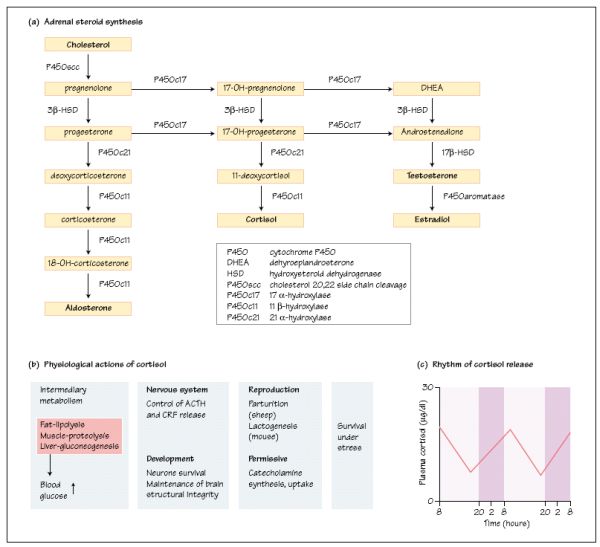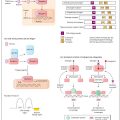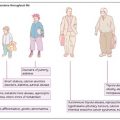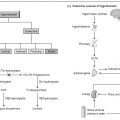
Congenital adrenal hyperplasia (CAH) describes a number of conditions arising from absence or impaired function of enzymes in the adrenal steroidogenic pathway. Over 95% of cases represent deficiencies in the 21-hydroxylase enzyme (21- OHD, ‘classical’ CAH), with abnormalities of 11 β-hydroxylase, 3β-hydroxysteroid dehydrogenase, 17α-hydroxylase and 20,22-desmolase deficiencies also being described (Fig. 19a).
The clinical features of CAH depend upon the genetic basis of the disorder in individuals. Thus, complete deletion of the 21-OH gene will produce the full-blown effects of CAH, whereas gene mutations may be responsible for lesser clinical features corresponding to impaired enzyme action. The clinical features of CAH can be surmised by consideration of the steroidogenic pathway. In classical 21-OHD with severe enzyme deficiency, androgen production is increased alongside decreased synthesis of Cortisol and aldosterone, leading to the typical clinical features of a newborn with ambiguous genitalia. In females this is generally identified at birth, so that early treatment prevents the onset of salt-losing crisis secondary to mineralocorticoid deficiency. In male babies, this may present as failure to thrive, and subsequent vomiting, diarrhoea and circulatory collapse are the presenting clinical features. Milder variants of classical 21-OHD may present in childhood with virilization and precocious puberty. Those with ‘non-classical’ forms of the disease may not present until early adulthood, usually young women with irregular menses and hirsutism. Treatment of CAH is by glucocorticoid replacement therapy, thereby restoring the negative feedback in the pituitary-adrenal axis and lowering the ACTH drive to androgen production. In young women with non-classical CAH this may be combined with antiandrogen therapy.
The molecular genetics of CAH have been the subject of much investigation. Prenatal diagnosis can be offered to affected families, either by chorionic villous sampling in the early stages of pregnancy or later amniocentesis. Prenatal treatment with glucocorticoids can prevent the virilization of a female fetus.
Physiological actions of Cortisol
Stay updated, free articles. Join our Telegram channel

Full access? Get Clinical Tree








